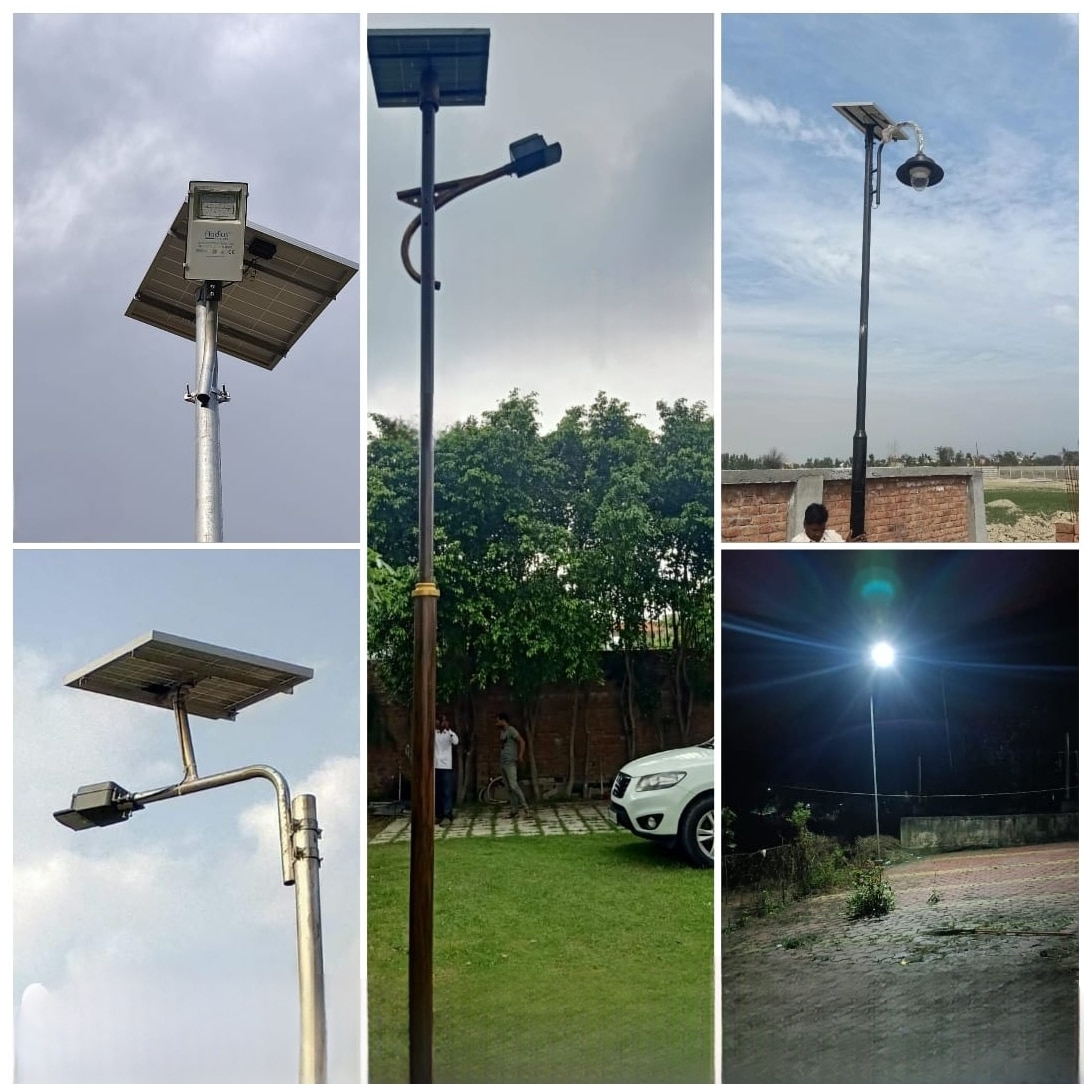Description
Product details
Solar street light is an elevated light source that is powered by photovoltaic (PV) panels, which typically mounted on the lighting structure or integrated into the luminaire itself. These innovative lighting systems harness the abundant energy of the sun during the day, store it, and then automatically illuminate roads, pathways, public spaces, and other areas at night. They represent a significant step towards sustainable urban and rural development by providing reliable, environmentally friendly, and cost-effective illumination. Key Components: A typical solar street light system comprises several essential components working in synergy: * Solar Panel (Photovoltaic Module): * Function: This is the heart of the system, responsible for converting sunlight (photons) directly into direct current (DC) electricity through the photovoltaic effect. * Types: Monocrystalline and Polycrystalline silicon panels are commonly used. Monocrystalline panels generally offer higher efficiency in smaller footprints. * Mounting: Often mounted on top of the pole, facing the sun, or integrated into the design (all-in-one lights). * Rechargeable Battery: * Function: Stores the electrical energy generated by the solar panel during the day for use at night. * Types: * Lead-Acid Batteries: More traditional, lower cost, but heavier and have a shorter lifespan. * Lithium-ion (LiFePO4) Batteries: Increasingly popular due to their higher energy density, longer lifespan, faster charging, and lighter weight. * Placement: Typically housed in a weather-proof enclosure at the top of the pole (in integrated designs) or in a battery box near the base. * LED Luminaire (Light Fixture): * Function: Emits light at night. LEDs (Light Emitting Diodes) are almost universally used due to their high energy efficiency, long lifespan, durability, and excellent light quality. * Features: Modern LED luminaires are designed for optimal light distribution (e.g., bat-wing optics for road lighting), minimal light pollution, and often include heat sinks for thermal management. * Charge Controller (Solar Charge Controller): * Function: This intelligent device acts as the "brain" of the system. It regulates the flow of electricity from the solar panel to the battery, preventing overcharging and deep discharging, which can damage the battery. It also controls the turning on and off of the light. * Types: PWM (Pulse Width Modulation) and MPPT (Maximum Power Point Tracking) controllers. MPPT controllers are more efficient, especially in varying light conditions, by extracting maximum power from the solar panel. * Features: Often includes features like automatic dusk-to-dawn operation, dimming profiles, motion sensing (PIR sensors), and temperature compensation. * Light Pole/Mounting Structure: * Function: Provides the necessary height and stability for mounting all the components. * Material: Typically galvanized steel or aluminum for durability and weather resistance. * Design: Can vary widely from simple straight poles to decorative or integrated designs. * Cables and Wiring: * Function: Connect all the components, ensuring efficient and safe power transfer. * Material: UV-resistant and weather-proof cabling is essential. Working Principle: The operation of a solar street light is straightforward and automatic: * Daytime (Charging): During daylight hours, the solar panel absorbs sunlight. The photovoltaic cells within the panel convert this solar energy into DC electricity. * Energy Storage: The electricity generated by the solar panel flows to the charge controller, which regulates it before sending it to the rechargeable battery. The battery stores this energy. * Dusk Detection: As dusk approaches and ambient light levels drop (detected by the charge controller or a built-in photosensor), the charge controller automatically switches on the LED luminaire. * Nighttime (Illumination): The stored energy in the battery powers the LED light, providing illumination throughout the night. * Morning (Turn-off): At dawn, when sufficient ambient light is detected, the charge controller automatically turns off the LED light and the charging cycle begins again. * Smart Features: Many modern systems incorporate motion sensors (PIR) that dim the light when no one is around and brighten it when motion is detected, further conserving battery power. Benefits of Solar Street Lights: * Environmental Friendliness: Zero carbon emissions during operation, relying on a clean, renewable energy source. Reduces reliance on fossil fuels. * Cost-Effectiveness: * No Electricity Bills: Eliminates ongoing electricity costs. * Reduced Installation Costs: No trenching or complex grid-tie wiring required, significantly lowering labor and material costs. * Low Maintenance: Generally requires minimal maintenance once installed. * Grid Independence: Operates independently of the electrical grid, making them ideal for remote areas, new developments, or places with unreliable grid access. * Safety and Security: Provides reliable illumination, enhancing safety for pedestrians and drivers, and deterring crime in public spaces. * Quick and Easy Installation: Relatively simple to install compared to traditional street lights, requiring less infrastructure. * Durability and Longevity: Designed to withstand various weather conditions; LED lights and LiFePO4 batteries have long operational lifespans. * Scalability: Easy to expand and install new units as needed without major infrastructure overhauls. Applications: Solar street lights are versatile and widely used in various applications: * Public Roads and Highways: Illuminating stretches where grid power is expensive or unavailable. * Residential Streets and Colonies: Providing safe and aesthetic lighting. * Parks and Gardens: Enhancing safety and usability of recreational areas at night. * Campuses (Educational/Corporate): Lighting pathways, parking lots, and common areas. * Industrial Areas and Warehouses: Providing security and operational lighting. * Remote and Rural Areas: Bringing light to off-grid communities. * Bus Stops and Public Transport Hubs: Improving visibility and security. * Parking Lots: Enhancing safety and convenience. * Walking Paths and Bicycle Trails: Ensuring safe passage for users. In conclusion, solar street lights are a smart, sustainable, and increasingly popular solution for modern illumination needs. They offer a compelling blend of environmental responsibility, economic efficiency.





